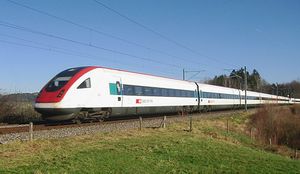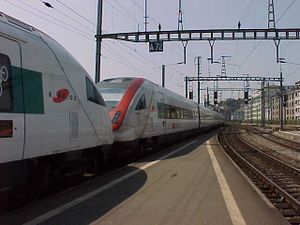SBB-CFF-FFS RABDe 500
The ICN (short for Intercity-Neigezug, German for Intercity Tilting Train), Series SBB RABDe 500, is a Swiss high-speed train which debuted on May 28, 2000, in time for Expo.02 held in western Switzerland in 2002. Its maximum velocity tops out at 200 km/h; realisation of services of this speed is planned for the near future. It was a joint development of Bombardier, SBB-CFF-FFS and Alstom
The ICN runs often with two complete compositions, each with seven carriages, including a dining car (which actually forms part of 2nd class). Four of the seven carriages are second class. In first class, some compartments feature electric power supply sockets and mobile phone reception enhancers. It was one of the first trains to feature passageways between the different compartments without any kind of door between the carriages.
The ICN came into service with a delay caused by the lack of supplies from ADtranz. Nevertheless, its rolling stock was fully in use by the time of the expo, and now there is enough rolling stock to let it be used on more than one line at the same time.
The ICN is run by Swiss Federal Railways. Pricing for train tickets carries no surcharges.
Services
The ICN began service on May 28, 2000, with services from St. Gallen via Winterthur, Zürich, Biel/Bienne through to Lausanne.
Services have now expanded to other areas of Switzerland, including Kreuzlingen, Basel and Geneva.
Two trains run every hour, alternating between: St. Gallen, Zürich, Biel/Bienne through to Geneva Airport or Lausanne; Basel, Biel/Bienne through to Lausanne or Geneva Airport.
Expo.02
| Wikimedia Commons has media related to: ICN trains |
Trainsets used for the Expo.02 national exposition in Switzerland carried a typewriter-font "permettre le futur" text on the outside of the train along with literary quotes from various prominent Swiss literature writers. In each train composition, a brief introduction of the featured writer was placed near the door.
Technical Information
The ICN is an emu - there is no locomotive in the classical sense. The Motors are located under the second class cars (2 front and 2 end cars of each trainset). The firstclass cars and the restaurant car are spared the electrical noises from the asynchronous motors. The ICN has a top speed of 200km/h. It currently operates at 160km/h due to lack of ETCS and because of the sinuous track geometry.



